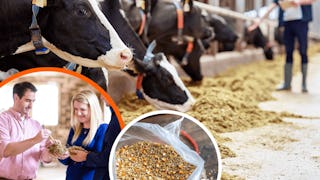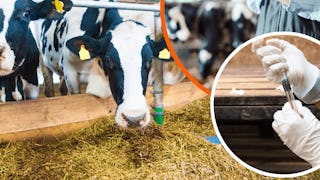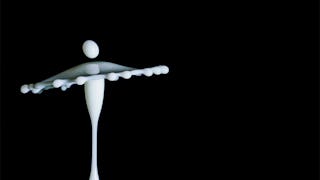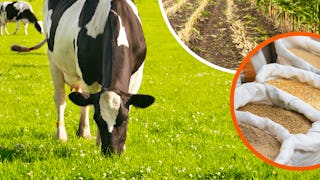This course offers a foundational introduction to lactation biology, focusing on the anatomy, development, and function of the mammary gland. Students will explore the processes of milk production, secretion, and removal, and examine the nutritional composition of milk—including fats, proteins, lactose, vitamins, and minerals. The course also covers milk’s role in human health, including infant development and lactose intolerance, as well as the significance of bioactive milk components. In the final module, learners will gain insight into mammary health, identifying common conditions like mastitis and edema, and exploring prevention strategies. Designed for learners from diverse backgrounds, this course provides a comprehensive overview of milk science and its biological and nutritional importance.

Enjoy unlimited growth with a year of Coursera Plus for $199 (regularly $399). Save now.

Discovering Dairy: What's in Your Milk?
This course is part of Dairy Nutrition for Udder Success Specialization


Instructors: Juan Loor
Included with
What you'll learn
Understand mammary gland anatomy and development stages.
Analyze milk composition and its nutritional variations.
Evaluate mastitis prevention strategies and treatments.
Skills you'll gain
Details to know

Add to your LinkedIn profile
August 2025
6 assignments
See how employees at top companies are mastering in-demand skills

Build your subject-matter expertise
- Learn new concepts from industry experts
- Gain a foundational understanding of a subject or tool
- Develop job-relevant skills with hands-on projects
- Earn a shareable career certificate

There are 4 modules in this course
In the course orientation, you'll get to know the course, your classmates, and our learning environment, and gain the technical skills needed. Then, start your journey into lactation science by exploring the anatomy of the mammary gland and the stages of its development. You'll also learn how milk is produced and removed through the processes of lactogenesis, secretion, and removal. By the end of this module, you'll have a solid understanding of how the mammary gland functions to support milk production.
What's included
12 videos4 readings2 assignments1 discussion prompt
Dive into the composition of milk and discover what makes it such a unique and nutritious food. You'll explore its major components—fats, proteins, lactose, vitamins, and minerals—and learn how different types of milk, such as organic, A2/A2, and rBST-free, compare. This module will help you explain the nutritional roles of milk’s key ingredients.
What's included
10 videos2 readings1 assignment
This module focuses on milk’s role in human nutrition and how it’s represented on store shelves. You'll learn about lactose intolerance, the health benefits of bioactive milk components, and milk’s importance in infant development. By the end, you’ll be able to interpret milk labels and understand milk’s broader dietary significance.
What's included
11 videos1 assignment
Explore the basics of mammary health, including common conditions that affect the udder. You'll learn to distinguish between mastitis and intramammary infections, recognize symptoms of mammary edema, and understand prevention strategies. This module lays the groundwork for identifying and managing udder health issues. At the conclusion of this module, you will be ready to complete the final assessment for the course and earn your Coursera certificate!
What's included
9 videos4 readings2 assignments
Earn a career certificate
Add this credential to your LinkedIn profile, resume, or CV. Share it on social media and in your performance review.
Offered by
Explore more from Animal Health
 Status: Free Trial
Status: Free TrialUniversity of Illinois Urbana-Champaign
 Status: Free Trial
Status: Free TrialUniversity of Illinois Urbana-Champaign
 Status: Preview
Status: PreviewUniversity of Illinois Urbana-Champaign
 Status: Free Trial
Status: Free TrialUniversity of Illinois Urbana-Champaign
Why people choose Coursera for their career





Open new doors with Coursera Plus
Unlimited access to 10,000+ world-class courses, hands-on projects, and job-ready certificate programs - all included in your subscription
Advance your career with an online degree
Earn a degree from world-class universities - 100% online
Join over 3,400 global companies that choose Coursera for Business
Upskill your employees to excel in the digital economy
Frequently asked questions
Yes! Although completion of the Coursera course alone is not credit-bearing, it is a required component of a graduate-level Canvas course that can be "stacked" toward advanced credentials such as an academic (transcriptable) graduate certificate or a degree. If you decide to pursue further education, the credits you earn from this course can be applied toward a formal academic program, provided that you meet all the requirements of admission to the certificate or degree.
To access the course materials, assignments and to earn a Certificate, you will need to purchase the Certificate experience when you enroll in a course. You can try a Free Trial instead, or apply for Financial Aid. The course may offer 'Full Course, No Certificate' instead. This option lets you see all course materials, submit required assessments, and get a final grade. This also means that you will not be able to purchase a Certificate experience.
When you enroll in the course, you get access to all of the courses in the Specialization, and you earn a certificate when you complete the work. Your electronic Certificate will be added to your Accomplishments page - from there, you can print your Certificate or add it to your LinkedIn profile.
More questions
Financial aid available,

